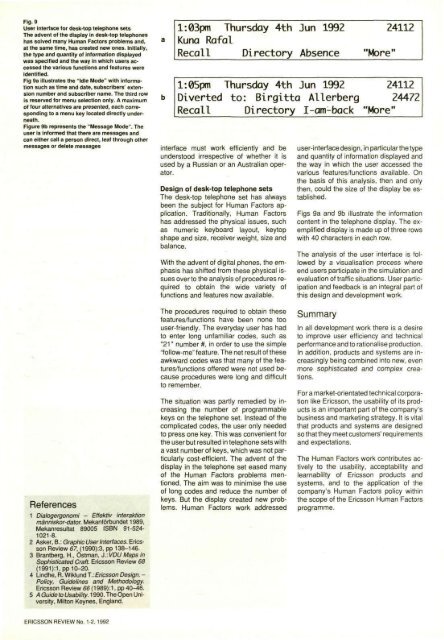Frame Relay - for Faster and More Efficient Data Communications ...
Frame Relay - for Faster and More Efficient Data Communications ...
Frame Relay - for Faster and More Efficient Data Communications ...
- No tags were found...
Create successful ePaper yourself
Turn your PDF publications into a flip-book with our unique Google optimized e-Paper software.
Fig. 9User interface <strong>for</strong> desk-top telephone setsThe advent of the display in desk-top telephoneshas solved many Human Factors problems <strong>and</strong>,at the same time, has created new ones. Initially,the type <strong>and</strong> quantity of in<strong>for</strong>mation displayedwas specified <strong>and</strong> the way in which users accessedthe various functions <strong>and</strong> features wereidentified.Fig 9a illustrates the "Idle Mode" with in<strong>for</strong>mationsuch as time <strong>and</strong> date, subscribers' extensionnumber <strong>and</strong> subscriber name. The third rowis reserved <strong>for</strong> menu selection only. A maximumof four alternatives are presented, each correspondingto a menu key located directly underneath.Figure 9b represents the "Message Mode". Theuser is in<strong>for</strong>med that there are messages <strong>and</strong>can either call a person direct, leaf through othermessages or delete messagesReferences1 Dialogergonomi - Effektiv interaktionmanniskor-dator. Mekan<strong>for</strong>bundet 1989,Mekanresultat 89005 ISBN 91-524-1021-8.2 Asker, B.: Graphic User Interfaces. EricssonReview 67, (1990):3, pp 138-146.3 Brantberg, H., Ostman, J.: VDU Maps inSophisticated Craft. Ericsson Review 68(1991):1,pp 10-20.4 Lindhe, R. Wiklund J..Ericsson Design. -Policy, Guidelines <strong>and</strong> Methodology.Ericsson Review 66 (1989):1, pp 40-46.5 A Guide to Usability. 1990. The Open University,Milton Keynes, Engl<strong>and</strong>.interface must work efficiently <strong>and</strong> beunderstood irrespective of whether it isused by a Russian or an Australian operator.Design of desk-top telephone setsThe desk-top telephone set has alwaysbeen the subject <strong>for</strong> Human Factors application.Traditionally, Human Factorshas addressed the physical issues, suchas numeric keyboard layout, keytopshape <strong>and</strong> size, receiver weight, size <strong>and</strong>balance.With the advent of digital phones, the emphasishas shifted from these physical issuesover to the analysis of procedures requiredto obtain the wide variety offunctions <strong>and</strong> features now available.The procedures required to obtain thesefeatures/functions have been none toouser-friendly. The everyday user has hadto enter long unfamiliar codes, such as*21 * number #, in order to use the simple"follow-me" feature. The net result of theseawkward codes was that many of the features/functionsoffered were not used becauseprocedures were long <strong>and</strong> difficultto remember.The situation was partly remedied by increasingthe number of programmablekeys on the telephone set. Instead of thecomplicated codes, the user only neededto press one key. This was convenient <strong>for</strong>the user but resulted in telephone sets witha vast number of keys, which was not particularlycost-efficient. The advent of thedisplay in the telephone set eased manyof the Human Factors problems mentioned.The aim was to minimise the useof long codes <strong>and</strong> reduce the number ofkeys. But the display created new problems.Human Factors work addresseduser-interface design, in particular the type<strong>and</strong> quantity of in<strong>for</strong>mation displayed <strong>and</strong>the way in which the user accessed thevarious features/functions available. Onthe basis of this analysis, then <strong>and</strong> onlythen, could the size of the display be established.Figs 9a <strong>and</strong> 9b illustrate the in<strong>for</strong>mationcontent in the telephone display. The exemplifieddisplay is made up of three rowswith 40 characters in each row.The analysis of the user interface is followedby a visualisation process whereend users participate in the simulation <strong>and</strong>evaluation of traffic situations. User participation<strong>and</strong> feedback is an integral part ofthis design <strong>and</strong> development work.SummaryIn all development work there is a desireto improve user efficiency <strong>and</strong> technicalper<strong>for</strong>mance <strong>and</strong> to rationalise production.In addition, products <strong>and</strong> systems are increasinglybeing combined into new, evenmore sophisticated <strong>and</strong> complex creations.For a market-orientated technical corporationlike Ericsson, the usability of its productsis an important part of the company'sbusiness <strong>and</strong> marketing strategy. It is vitalthat products <strong>and</strong> systems are designedso that they meet customers'requirements<strong>and</strong> expectations.The Human Factors work contributes activelyto the usability, acceptability <strong>and</strong>learnability of Ericsson products <strong>and</strong>systems, <strong>and</strong> to the application of thecompany's Human Factors policy withinthe scope of the Ericsson Human Factorsprogramme.ERICSSON REVIEW No. 1-2, 1992















